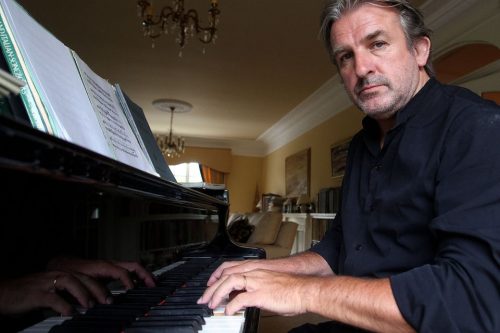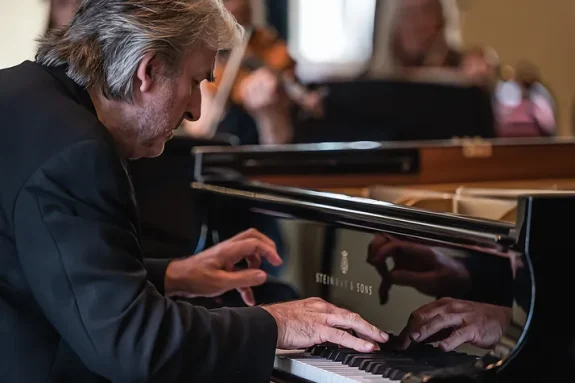 United Kingdom Clandeboye Festival 2024 [3] – Schubert, Prokofiev: Barry Douglas (piano). Clandeboye Estate, Northern Ireland, 22.8.2024. (RB)
United Kingdom Clandeboye Festival 2024 [3] – Schubert, Prokofiev: Barry Douglas (piano). Clandeboye Estate, Northern Ireland, 22.8.2024. (RB)

Schubert – Piano Sonata in G, D894; Impromptus, D899 Nos. 1, 3 & 4
Prokofiev – Piano Sonata No.7 in B-flat, Op.83
Barry Douglas has become very closely associated with the music of Schubert over the last few years, given his project to record the complete piano sonatas. He also recorded Prokofiev’s Seventh Sonata at a much earlier stage in his career.
He opened this recital with Schubert’s Sonata in G Major, D894 which was composed in 1826 towards the end of the composer’s life. It was the last of Schubert’s piano sonatas published during his lifetime. The publisher described the first movement as a ‘Fantasie’ and the work is sometimes referred to as a Sonata Fantasie. It is an unusually serene and intimate work.
Douglas is often seen as a pianist with a big sound, but I was struck by how reined in he was in these performances of Schubert. He succeeded in drawing the audience in to Schubert’s intimate sound world in his performance of the G major Sonata. The opening chords were perfectly weighted, the dynamics beautifully calibrated, and there was excellent layering of sound. Douglas was very attentive to tone production throughout and succeeded in maintaining tonal beauty in the very loud sections of the movement. The Andante second movement opened with a melody of unaffected lyricism. Douglas invested the ensuing dramatic outbursts with weight and depth of sound and there was a startling contrast with the quieter sections which had a ruminative meditative feel. I particularly loved Douglas’s exquisite playing of the Trio in the third movement. This succeeded in getting to the heart of Schubert at his most intimate. The finale was radiant and playful in turn and the C minor melody in the central section was hauntingly beautiful.
Schubert’s first set of Impromptus, D899 were written in 1827, the year after the G major Sonata. The first two were published during Schubert’s lifetime and the others after his death. Douglas omitted the second Impromptu in E-flat from this performance.
The C minor Impromptu opened in dramatic fashion with unison octaves. There was an immediate contrast with the hushed unaccompanied march-like melody which followed. Douglas coaxed gorgeous colours from his Steinway in the various transformations of the theme and he made the piano sing. My one quibble was around the pulse of the music which seemed a little erratic on occasion. Douglas transformed the G-flat Impromptu into a luminous song without words, albeit with dark undercurrents. One could not help but be swept up in the beauty of the melodies and the poetic handling of the modulations. The A-flat Impromptu opened with light glistening arpeggios cascading down the keyboard. As the melody emerged, Douglas’s use of rubato sounded entirely natural and unforced, and the music was infused with Viennese charm. In the central section the contrast between the major and minor key sections allowed us a glimpse into the volatile and precarious nature of the composer’s emotions.
The final work on the programme was the second of Prokofiev’s ‘War Sonatas’. Prokofiev started work on his Seventh Sonata in 1939 and the work was completed in 1942. The composer’s close friend, Vsevolod Meyerhold, was arrested by the Soviet secret police immediately before the composer started work on the sonata in June 1939 and he was shot on 2 February 1940. Given this backdrop, the three ‘War Sonatas’ are in many ways as much a reaction to Stalin’s purges as they are to the build up to the Second World War.
Douglas’s performance of the opening movement, marked Allegro inquieto, was spiky and trenchant. He clearly relished the diabolism in the opening section with its biting sarcastic accents. The slower second theme with its wandering harmonies suggested an unsettled paranoid mood. Douglas skilfully suggested orchestral sonorities at various points in the movement although occasionally I would have preferred less pedal as some detail was obscured. The Andante caloroso can sometimes be difficult to bring off in performance because of the way in which the music drifts though various tonal centres after the initial opening theme. Douglas brought an impressive sense of structure to the movement and the central section which culminates with bell like sonorities was very compelling. The final Precipitato was an adrenaline-fuelled virtuoso tour de force. Douglas brought rhythmic dynamism to the music and seemed to relish Prokofiev’s highly original pianistic effects.
Overall, this was a first-rate recital from Barry Douglas.
Robert Beattie
Featured Image: Barry Douglas
